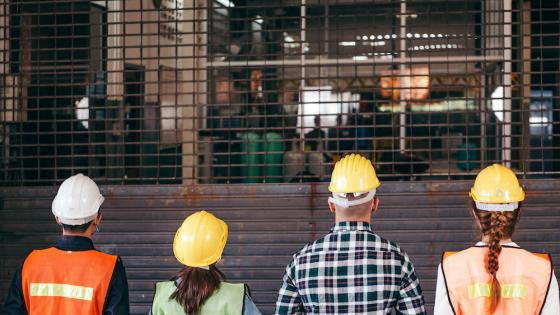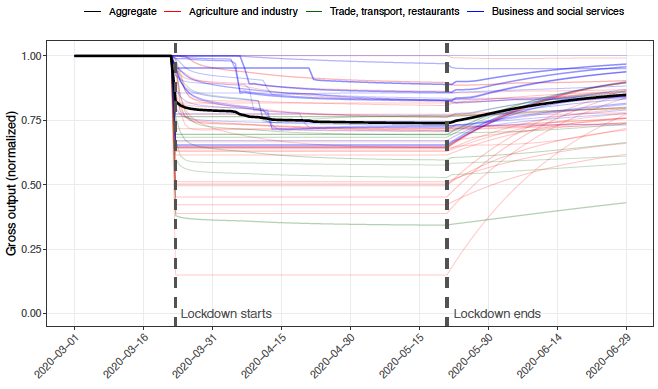The economic disruptions caused by the COVID-19 pandemic are large and have affected some industries and occupations more than others (Koren and Peto 2020, del Rio-Chanona et al. 2020). For example, labour supply shocks strongly affected construction, but were absent in sectors considered essential. Yet, given the interconnected nature of the economy, even the sectors shielded from the direct shocks eventually face adverse consequences. First-order shocks are amplified through production networks and the interaction of supply and demand (Inoue and Todo 2020, Barrot et al. 2020, Mandel and Veetil 2020, Bonadio et al. 2020, Baqaee and Farhi, 2020). For instance, in Norway, within a month, two thirds of the layoffs happened in businesses that were not directly hit by the shocks (Alstadsæter et al. 2020).
Governments that are now seeking to re-open their economies cannot ignore these network interactions. To determine the relative economic boosts of different re-opening scenarios, they need to consider the risks of an unbalanced re-opening that may worsen supply chain bottlenecks. Besides, they must also consider that the risk of infection faced by workers varies across industries and search for an appropriate compromise between increasing economic output and controlling the epidemic spreading.
In a recent paper (Pichler et al. 2020), we investigate several scenarios for the phased re-opening of the UK economy by modelling production network effects explicitly. At one extreme, we find that re-opening only a very limited number of industries can create supply chain ‘mis-coordination problems’ that may even decrease aggregate output. At the other extreme, re-opening all industries without extra precautionary measures would increase the epidemic reproduction number (R0) to above one, and may cause a second wave of the epidemic. Our results suggest that there is a reasonable compromise that yields a relatively small increase in epidemic spreading and delivers a substantial boost in economic output.
A model tailored to the COVID-19 pandemic
In an interconnected economy, it is intrinsically difficult to assess the economic impact of re-opening only some industries. Each industry relies on other industries, sometimes critically. For example, the metal manufacturing industry cannot operate without supplies from the mining industry. Opening parts of the economy without considering these relationships could cause severe supply chain disruptions.
We designed a novel economic model that acknowledges the unique features of the current crisis, and specifically (i) deals simultaneously with supply and demand shocks, (ii) allows for sluggish consumption recovery, and (iii) incorporates sectoral inventory buffers. The core of the model is an industrial production network that distinguishes between critical and non-critical inputs. To determine which inputs are critical, we use a survey of IHS Markit industry analysts, who were asked “Can production continue in industry X if input Y is not available for two months?”.
Our model is calibrated to the UK economy and initialised with first-order supply and demand shocks derived in del Rio-Chanona et al. (2020). Validation exercises show that our model is in good agreement with recent estimates from the Office for National Statistics (ONS) and is in line with the sectoral unemployment data of the US. Our model predicts a reduction in GDP of 1.7% for the first quarter and a reduction of 21.5% for the second quarter of 2020 (compared to the last quarter of 2019). These estimates are in the range of other forecasts for the UK economy, although on the more pessimistic side.
Figure 1 Simulation results for implementing and unwinding the UK lockdown
As in most economic models, the predicted outcomes depend fairly strongly on the choice of the production function. We assume that non-critical inputs are not necessary (to avoid the unrealistic collapse of the economy that would take place under a standard Leontief model). However, we do assume that critical inputs are absolutely necessary, and in fixed proportion, leading to non-trivial network effects. For instance, we find the counter-intuitive result that re-opening only a few industries can lower aggregate output. This happens because when some sectors of the economy are output-constrained, other industries compete for these scarce inputs. Important industries may then run out of inventory and eventually lack critical inputs to operate.
If re-opening only a handful of selected industries can cause problems, re-opening should be broad enough. However, this can of course be very risky in terms of infections. This prompted us to evaluate the effects of the re-opening scenarios on R0, the reproduction number of the epidemic. We decompose the epidemic transmission rate into five sources of infections: infections at the workplace, at school, during consumption activities, during commuting, and finally, infections that are not influenced by whether or not an industry is open. We also estimate the infection risk in each industry. For instance, the healthcare sector is responsible for more work-related infections than the forestry sector. This is because health workers have more contacts, each contact has a higher infection risk, and there are more healthcare than forestry workers overall. As another example, the retail and restaurant sectors contribute much more to consumption infections than the mining sector, because there are virtually no direct consumption activities in the mining industry.
By splitting sources of infection by economic activity, we can assess both the economic and epidemic impact of different scenarios.
Re-opening scenarios
We then use this simple epidemic model to study five re-opening scenarios. First, to establish a proper benchmark, we quantify the effect on epidemic spreading if the lockdown continues. Second, we analyse the impact of fully re-opening agriculture, mining, manufacturing, and construction (which were not entirely closed during the UK lockdown). Third, we open all upstream industries but leave all non-essential sectors in consumer-facing industries closed (retail, accommodation and food, recreational and personal services). The fourth scenario is the same as the third but assumes that schools are fully open instead of receiving only children of workers who cannot work from home. In the fifth scenario, we re-open all industries for work and consumption.
Figure 2 shows the economy-epidemic trade-off. There is considerable uncertainty in our predictions, but one conclusion appears robust: A large part of the ‘upstream’ economy (that was closed until recently) tends to have a relatively lower risk for workers, little risk for consumers, and also has higher economic value. Essentially, this is because large parts of manufacturing and business services have high ‘value-added’ and are upstream, meaning that they provide inputs to other industries. Also, these upstream industries are rarely selling directly to consumers, and thus present limited risks in their contribution to the pandemic. As a result, there is a ‘sweet spot’ in which we can re-open upstream industries but leave many consumer-facing industries closed. This results in a relatively small increase in risk of infection and a significant economic boost.
Figure 2 How different re-opening scenarios impact R0 and GDP
Notes: The left-hand vertical axis shows the reproduction number R0 (multi-coloured bars). The right-hand vertical axis gives the share of GDP compared to pre-lockdown levels (blue bars).
As Figure 2 makes clear, the scenario “All except consumer-facing industries” increases the reproduction number only marginally but increases GDP by 8%, relative to lockdown a month after these industries are re-opened. In contrast, re-opening the entire economy only increases GDP by an additional 2%. Thus, our recommended scenario has most of the economic benefits, and only minimal cost in terms of increased infections. Of course, there remains a lot of uncertainty in many estimates, and we cannot be sure that this scenario would not bring R0 above one. Similarly, we cannot be sure that re-opening completely would bring R0 above one (if stringent physical distancing and environmental health measures are in place). However, our results do indicate that the cost-benefit ratio of an industry being open is likely to be lower for upstream industries.
References
Alstadsæter, A, B Bratsberg, G Eielsen, W Kopczuk, S Markussen, O Raaum and K Røed (2020), “The First Weeks of the Coronavirus Crisis: Who Got Hit, When and Why? Evidence from Norway”, Covid Economics 15.
Baqaee and Farhi (2020), “Nonlinear Production Networks with an Application to the Covid-19 Crisis”, CEPR DP14742.
Barrot, J-N, B Grassi and J Sauvagnat (2020), “Sectoral effects of social distancing”, Covid Economics 3.
Bonadio, B, Z Huo, A A Levchenko and N Pandalai-Nayar (2020), “Global supply chains in the pandemic”, CEPR DP14766.
del Rio-Chanona, R M, P Mealy, A Pichler, F Lafond and J D Farmer (2020), “Supply and demand shocks in the COVID-19 pandemic: An industry and occupation perspective”, Covid Economics 6.
Inoue, H and Y Todo (2020), “The propagation of the economic impact through supply chains: The case of a mega-city lockdown against the spread of COVID-19”, Covid Economics 2.
Koren, M and R Peto (2020), “Business disruptions from social distancing”, Covid Economics 2.
Mandel, A and V P Veetil (2020), “The economic cost of COVID lockdowns: An out-of-equilibrium analysis”, SSRN 3588421.
Pichler, A, M Pangallo, R M del Rio-Chanona, F Lafond and J D Farmer (2020), “Production networks and epidemic spreading: How to restart the UK economy”, Covid Economics 23.
Endnotes
1 https://www.gov.uk/government/collections/data-forecasts










